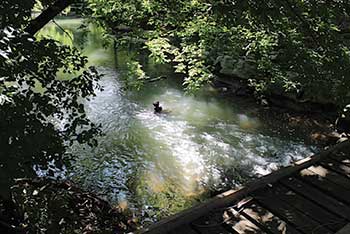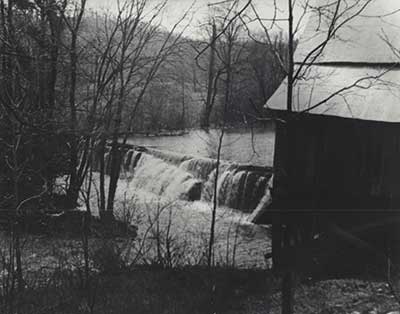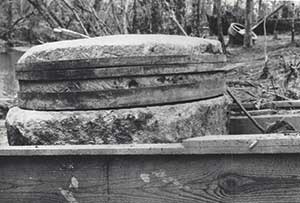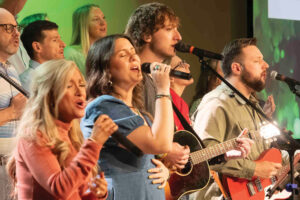
Story by Joe Whitten
Photos by Mackenzie Free
and submitted Photos
Some of our readers are of an age to remember a family farmhouse with a wood-burning cookstove in the kitchen. As memory pulls them into distant reveries, the smell of cornbread browning in the oven is so real that mouths begin to water. On the table sits the fresh-churned butter that will crown a slice cut steaming from the cast iron skillet.
Then, as memory fades into 2023 reality, they realize a skillet of cornbread baking in a gas or electric oven smells just as good.
Two hundred years ago in St. Clair County, the meal for that “bread of memory” came from a local gristmill that had ground the farmer’s homegrown, dried and shelled corn.
In the book, Anthology of People – Places – Events of St. Clair County, Mattie Lou Teague Crow (1903-1999) in her article, “Mills in the Valley,” records that before the construction of local gristmills, “The man of the family often traveled all the way back to Georgia or Tennessee to have corn ground into meal. In time, each community had its own gristmill.”
Later in the article she laments that “Today we buy … a box of corn muffin mix, which (Tennessee) Ernie Ford assures us is ‘pea-picking good.’ But it’s a sad thing that today’s generation will never know what real cornbread was like. Corn pone. Egg bread. Spoon bread. Johnny cake. Crackling bread. Corn dodgers. Hush puppies. Today’s variety is a pale imitation of the bread our grandparents made from that wonderful water-ground meal.”
Yarbrough Mills
Manoah Yarbrough no doubt built the first gristmill on Beaver Creek c1823. He moved his family from North Carolina to St. Clair County in 1822. His original destination was Choccolocco Valley in Calhoun County, but after learning of the Indian unrest in that area, he settled in St. Clair County.
According to an article written by Fitzgerald Yarbrough for The Heritage of St. Clair County, Manoah, having run corn and flour mills in North Carolina, had “brought his mill, including the mill rocks, with him,” and soon after getting “the family settled, he began constructing a dam across Beaver Creek to furnish power for his grist and flour mills. The dam is approximately 450 feet long and is built of mountain rock and dirt.”
Fitzgerald was proud of the fact that “The original dam is still used today as a roadbed leading to a bridge which crosses Beaver Creek. … The bridge foundation is the original dam where the water gates were.” Fitzgerald and his two sons, Fitz and Burk, constructed the bridge in 1985.
In the fall after the harvest and through the winter months, the family and farm workers added height to the dam “… to give a greater head of water so more machinery could be added.” Manoah died in 1840, and his son, Littleton, continued running the mill and making improvements.
In addition to corn and flour mills, over time, the Yarbrough mills included a sawmill, a shingle mill and a wool carding mill. Fitzgerald wrote of Littleton’s son, “My grandfather, John Yarbrough, Sr., ran the wool carding mill to make wool yarn for the Confederate Army during the Civil War. He was only 13 years old when the war began.” John Yarbrough, Sr., added a cotton gin, which operated until about the time WWI began.
The traditional waterwheel powered the mill until the 1880s. By then, Littleton had died and his son, John Yarbrough, mentioned above, operated the mills and continued making improvements to them.
“The turbine water wheel (that John purchased) was known as Morris Wheel,” Fitzgerald wrote, “because it was constructed at Morrisville, Alabama, and sold to my grandfather by John and Elbert Morris.”
When John and Elbert Morris came to Beaver Valley to install the Morris Wheel, romance blossomed between them and two of Fitzgerald’s aunts, for “A few years later, John Morris married my aunt Mae,” he wrote, “and Elbert Morris married Aunt Jennie.”
At the location of the mill, Beaver Creek flows wide and sparkling in the sun. The mill dam allowed a large lake to form above it which became a place local folk enjoyed for fishing, camping, swimming, fish fries and picnics.
With the passing decades, sediment built up behind the dam, thus reducing the volume of water in the lake. The Yarbroughs estimated that between the years 1823 and 1925, eight feet of sediment accumulated. Then in 1925, an exceptional flood washed out the water gate and swept the waterwheel downstream about 50 feet from its original location in the water house, which was also damaged by the flood waters and never rebuilt.
The waterwheel, still attached to its wooden frame, lies today in the waters of Beaver Creek and has not been removed for two reasons recorded by Fitzgerald: “(1) Its weight. It is very heavy, and (2) It is better preserved under water than if it was raised and exposed to the elements.”
The Yarbrough mill functioned for more than 100 years. The corn and flour mill stones carted here from North Carolina remain in the family. And from the sawmill, several 19th century homes constructed by Littleton Yarbrough, with lumber sawn in his mill and dried in his kiln, remain in the Beaver Valley today. The kiln lay east of the dam and the outline of the rock foundation and sides remain visible today. In addition to these Beaver Valley homes, the Ashville Courthouse and the second Ashville Baptist Church building were constructed with lumber from the Yarbrough mill.
Abernathy Grist Mill
In the previously mentioned book, Anthology of People – Places – Events of St. Clair County, Larry McCullough wrote the article, “History of the Abernathy Grist Mill,” from history he collected from L.E. Abernathy and V. Ray Thompson. Larry wrote, “The Abernathy Grist Mill once located in Beaver Valley was purchased in 1918 by M.R. Abernathy after the sawmill he operated in Ashville was destroyed by fire. The mill was previously known as the Gilchrist Mill, though it is unclear who actually built the mill or when it was built.”
However, in the same Anthology, Lura Jean Cobb Smith, a Gilchrist descendant, has an article titled “Who Built the Mill?,” wherein she stated, “My Great-Grandfather, Truss Vann Gilchrist brought his family from Calhoun County to St. Clair County, bought farmland in the valley of Beaver Creek, on October 28, 1879. He and my grandfather, John Dudley Gilchrist, built the Mill now known as Abernathy Mill.” The rest of the article relates Gilchrist genealogy and family history.
In a recent interview, Judith Ramsey Abernathy recalled information her husband, Bob Abernathy, had gleaned about his grandfather, Marion R. Abernathy, who bought and ran the mill. “The Abernathy family lived in Cherokee County where, as carpenters and millers, they designed mills, dams and raceways – flumes for carrying water. The family mills there included a gristmill, sawmill and cotton gin.”
Marion was five years old when his father died. In those days, children in large families grew up learning how to work, and so did Marion. In the 1880 US Census, he is listed as a farm hand and living with his cousin in Cherokee County, Alabama. Then in later censuses, he is in St. Clair County.
The Abernathy family were related to the St. Clair County Lindsey family who “… had a mill on Canoe Creek northeast of Ashville,” said Judith, “and we believe that is why Marion came to St. Clair County.”
“The mill sat on a large lake created by dams on the creek,” she related. “Bob’s mother recalled seeing large trout in the lake. They built a big farmhouse on the Beaver Creek property. It had a dogtrot through the center and many large rooms.”
Larry McCollough describes the remains of the mill. “The dam is still intact except for a 20-foot section on the south side of the creek. The dam stretches 80 feet from end to end, stands 15 feet tall and is 10 feet thick at the base. Some of the rocks making up the dam are half as large as automobiles.”
According to Larry’s article, the millhouse was a wood frame structure that stood two stories high and sat “…atop the dam on the northside of the creek. …A cotton gin occupied the top floor, though the gin machinery was never used by Mr. Abernathy.”
The Abernathy mill never had the traditional waterwheel, so when time came to grind corn, the miller raised a sluice gate in the dam to release the water. “The water was directed through a water turbine. …The turbine converted the rushing water into power that turned various gears and shafts, finally setting into motion one of the 800-pound millstones. One stone turned in a circular motion (this one had to be balanced) while the other remained stationary during the grinding.” The ground corn meal fell into a hopper under which the miller had placed a sack into which he released the meal.
Margaret Franklin Berry, who grew up in Slasham Valley, remembers this process from the mid-to-late-1940s. “When we needed corn meal, my parents would send my brother and me out there to shell corn. I remember we shelled gallon buckets of corn. My daddy would take it to the mill to have it ground, and I’d go with him. I just thought that was fascinating to watch that man pour that corn into that hopper, and it come out cornmeal.” She couldn’t remember the name of the mill, but her description seems to indicate the Abernathy Gristmill.
Larry also pointed out that the millstones’ grooves would wear down from the grinding and required regrooving periodically. The miller used a hammer and chisel for this job. This chiseling left grit in the grooves for several days afterward, and during those days, the miller ground only chicken feed until the grit was gone.
Just as at the Yarbrough mill, the Abernathy millpond was a social gathering place where people could swim and fish in the cool water and then picnic on the bank.
In the early 1940s, unusually heavy spring rains caused Beaver Creek flooding, which swept the Abernathy millhouse off its foundations. At the time Larry wrote the article in 1985, “Boards, rafters and heart pine logs can still be seen beneath the clear waters, looking like the wreckage of a Spanish galleon.”
Time no doubt has taken its toll on those timbers the passing years. The millstones were retrieved by Larry and remain preserved at his home today.
According to Judith Abernathy, after the storm washed the Beaver Creek mill away, “Marion purchased land in Ashville and built a new home. He also began operating a heading mill, making wooden barrelheads. This mill was located at the corner of Highway 23 and 7th Avenue in Ashville. Every day at noon, a steam whistle would blow at the mill.”
The Cox Mill
In an article on file at the Ashville Museum and Archives, Margaret Coker wrote of the Cox Gristmill in a paper titled, “Childhood Memories of an Old Gristmill.” Henry Cox operated this mill in Beaver Valley. According to Mr. Cox’s obituary in The Southern Aegis, Nov. 8, 1928, he became blind at the age of 12, and in spite of his blindness, as an adult he delivered mail in Beaver Valley for 15 years.
The Cox gristmill had the traditional waterwheel, and the dam across the creek formed a millpond. When the miller opened the water gate, the rushing water turned the waterwheel to power the mill.
“I remember helping my father by turning the handle of the corn sheller while he fed the ears into it,” Mrs. Coker wrote. “Then the corn was sacked and taken to the Cox Gristmill.” Folk could have their corn ground fine, medium or coarse.
“I remember as a small child going to the mill with my father in a wagon,” she wrote, “and then later in an early model Ford car. Some customers came bringing their sacks of corn across the backs of the horses or mules they were riding. Others came in buggies or wagons.”
She drew a word picture with this recollection from the past. “One of the pleasant memories of my childhood was walking into my mother’s kitchen and smelling the enticing aroma of hot cornbread just out of the oven of the wood burning stove. Even better was the taste of the bread when a slice of it was filled with home churned butter.”
The wonderful thing is a wood burning stove is not required for making family memories of your own. So, go to the store and purchase some self-rising corn meal – and a pound of real butter. For dinner tonight, open a jar of the vegetable soup you canned this past summer. Turn your oven – gas or electric – to 425 degrees and put the oiled iron skillet in the oven while it heats. A sizzling hot skillet gives a good crust to the cornbread. If you don’t have a recipe, there will be one on the bag of cornmeal you bought, or you can call your mother, your grandmother, an aunt, or a friend for their recipe.
Over the past 100 years, sugar has crept into cornbread recipes in the South, but for true, old-timey Southern cornbread, cooks don’t add sugar to the batter. Beloved storyteller, Sean of the South, addressed this in his Nov. 2, 2022, online blog titled, “For the Love of Cornbread,” when he wrote:
“Only a few days ago, I visited a restaurant in Franklin, Tennessee. It was one of those fancy joints where waiters and waitresses walk like they’re in need of fiber supplementation. The waitress brought me a hot basket of sweet cornbread.
“ ‘Excuse me, ma’am,’ I said to the waitress. ‘There’s something wrong with my cornbread.’
“‘What’s wrong?’ she said.
“ ‘Well, I think the chef spilled a box of Duncan Hines into the batter.’
“No, sir, we put sugar in our cornbread.”
“ ‘Why would you do such a thing?’
“Because our chef is from Chicago.”
And cornbread lovers all over the South murmured commiserations along with Tennessee Ernie Ford, “Well bless his pea-picking heart!”


















